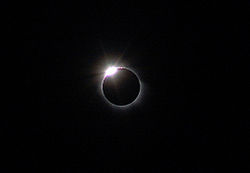Solar eclipse
A solar eclipse is an astronomical event which occurs when the Moon blocks out the Earth's view of the Sun. This type of eclipse can only occur because of the precise placement of the Earth and its moon in relationship to the sun and in relationship to their size.
The sun's distance for Earth (149,597,870 km) is approximately 400 times the distance between the Earth and the Moon (about 370,000 km), although the Moon's elliptical orbit causes the distance between the Earth and the Moon to change slightly during the month; likewise, the sun's circumference (4,379,000 km) is approximately 400 times the circumference of the Moon (10,921 km).
- 149,597,870 km / 370,000 km = ~404.31
- 4,379,000 km / 10,921 km = ~400.97
If it weren't for this relationship between the Sun's distance from the Earth, the Moon's distance from the Earth, and between the sizes of the two objects, a solar eclipse would not be possible; suggesting the moon's placement was chosen by God rather than simply by random chance.
Effect of the Lunar Orbit
Calculating the dates of a future Solar Eclipse is complicated because the orbit of the moon around the earth is slightly irregular and tilted. Since the earth is in orbit around the center of the sun, the earth follows a circle that always lies in the same plane with the center of the sun. If the moon's orbit around the earth were perfectly circular and lay in the same plane as the earth's orbit around the sun, we would have a solar eclipse every month (and a lunar eclipse too). However, the lunar orbit is tilted by about 5 degrees from the earth orbital plane.
"The Moon's orbit is inclined 5.145396° with regard to the ecliptic (the plane in which the Earth's orbit around the Sun lies or, more precisely, the plane in which the centre of gravity of the Earth-Moon system (its barycentre) orbits the Sun), so as seen from the centre of the Earth the Moon drifts up and down slightly more than five degrees in the course of each orbit."
Thus we can only have a solar eclipse about twice a year, when the point where the moon's orbit crosses the plane of the earth's orbit lies exactly between the sun and the earth. Another way of looking at it is that there cannot be an eclipse unless the moon's path in the sky crosses the sun's path in the sky (called the ecliptic) during a new moon.
Eclipse Types
During a Solar Eclipse, there is a large area of the earth where the sun is only partly covered, and a small area where the sun is completely covered for a short time. In any one place, some eclipses are partial, while others are total. Most places on earth see a total eclipse sooner or later, but it might take thousands of years between eclipses. But, nearly every year, somewhere on the earth has a total eclipse, although it is in a different place each time.
Solar Eclipses are categorized as:
- Total when the shadow of the moon falls on some place on the earth, darkening it completely (about like twilight after sunset but not as dark as full night);
- Partial when the shadow of the moon misses the earth completely;
- Annular when the moon is slightly farther away from the earth so that in the center of the shadow a ring of the outside of the sun is still visible;
- Hybrid when the eclipse is Total in part of its path on the earth, and Annular in another part.
Eclipse Dates
NASA gives the following information about Solar eclipse dates"[2] including the Saros Number and where it will pass.
| 2010 Jan 15 | Annular | 141 | Africa, Indian Ocean, and SE Asia |
| 2010 Jul 11 | Total | 146 | South Pacific, Southern tip of South America |
| 2011 Jan 04 | Partial | 151 | Europe, Africa, central Asia |
| 2011 Jun 01 | Partial | 118 | E Asia, n N. America, Iceland |
| 2011 Jul 01 | Partial | 156 | S Indian Ocean |
| 2011 Nov 25 | Partial | 123 | S Africa, Antarctica, Tasmania, N.Z. |
| 2012 May 20 | Annular | 128 | Asia, Pacific, N. America [Annular: China, Japan, Pacific, w U.S.] |
| 2012 Nov 13 | Total | 133 | Australia, NZ, s Pacific, s S. America [Total: n Australia, s Pacific] |
| 2013 May 10 | Annular | 138 | Australia, N.Z., c Pacific [Annular: n Australia, Solomon Is., c Pacific] |
| 2013 Nov 03 | Hybrid | 143 | e Americas, s Europe, Africa [Hybid: Atlantic, c Africa] |
| 2014 Apr 29 | Annular | 148 | s Indian, Australia, Antarctica[Annular: Antarctica] |
| 2014 Oct 23 | Partial | 153 | n Pacific, N. America |
| 2015 Mar 20 | Total | 120 | Iceland, Europe, n Africa, n Asia[Total: n Atlantic, Faeroe Is, Svalbard] |
| 2015 Sep 13 | Partial | 125 | s Africa, s Indian, Antarctica |
| 2016 Mar 09 | Total | 130 | e Asia, Australia, Pacific[Total: Sumatra, Borneo, Sulawesi, Pacific] |
| 2016 Sep 01 | Annular | 135 | Africa, Indian Ocean[Annular: Atlantic, c Africa, Madagascar, Indian] |
| 2017 Feb 26 | Annular | 140 | s S. America, Atlantic, Africa, Antarctica [Annular: Pacific, Chile, Argentina, Atlantic, Africa] |
| 2017 Aug 21 | Total | 145 | N. America, n S. America[Total: n Pacific, U.S., s Atlantic] |
It is interesting that the solar eclipse on September 13, 2015 comes one day before the Jewish festival of Rosh Hashana (Feast of Trumpets). However this is a partial eclipse that will not even be seen in Israel.
Biblical Record
References
- Smith’s Revised Bible Dictionary, 1999

